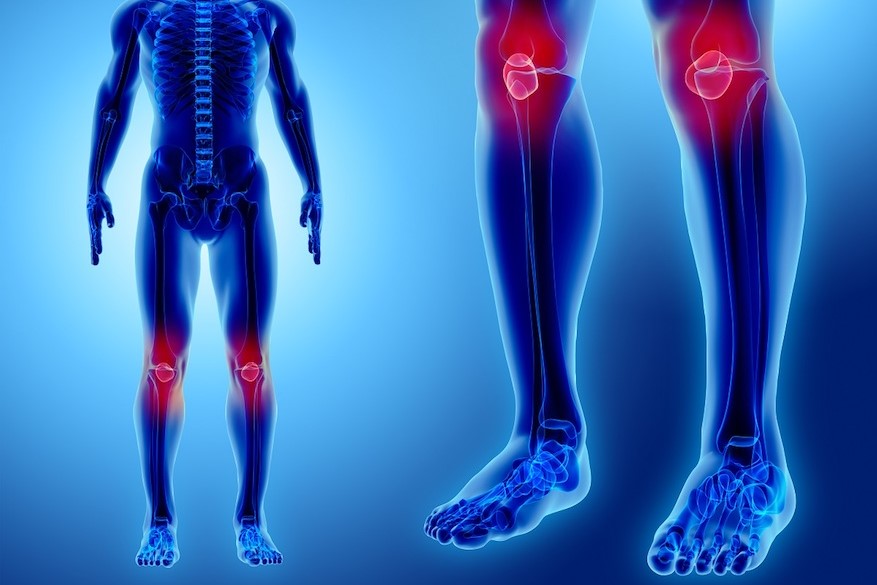
Knee pathologies: patellofemoral syndrome
Patellofemoral syndrome: the patella conveys the force of the quadriceps muscle, allowing the extension movement of the knee. It acts as a ‘pulley’, sliding above the femur, inside a special ‘gutter’, called the trochlea
Pain in the anterior area of the knee
In a large number of patients, the so-called patellofemoral syndrome occurs, i.e. the onset of pain in the anterior area of the knee, linked to the malfunction of the sliding mechanism between the patella and the femur.
Symptoms
The pain, which can be very significant, arises suddenly, sometimes without any reason, also leading to a blockage of the joint of an antalgic nature.
Causes of patellofemoral syndrome
To understand the nature of the problem, we must understand the mechanical reason for it.
The pain is related to inflammation of the cartilage of both the patella and the femoral eaves (chondropathy).
This inflammation is linked to poor patellar sliding during flexion-extension of the knee.
In particular, the patella becomes ‘lateralised’, i.e. it slides more on the outer edge of the knee, increasing friction with the femur.
This ‘lateralisation’ also called ‘external hyperpressure’ or ‘patellar malalignment’ can be due to 3 main situations
- Quadriceps hypotrophy
- Functional overload in knee flexion
- Anomaly of the femoral gutter anatomy
Quadriceps hypotrophy is the cause that mostly leads to this syndrome (90% of patients); the stabilising force of the muscle, which first opposes the lateralisation of the patella, is lacking.
At other times, there may be a cause linked to overexertion, as in those patients in whom pain is triggered after a ‘walk’ in the mountains, or a heavy sports session, especially if one has played a sport with the knee flexed (e.g. volleyball).
In a very small proportion of patients, the problem may instead be due to an anatomical abnormality of the femoral gutter, which is ‘flared’ and therefore poorly contains the patella.
These patients usually also have a history of repeated ‘dislocations’ of the patella, resulting in painful ‘reductions’ in the emergency room.
Patellofemoral syndrome, the diagnosis
Conventional radiology, performed with the knee in flexion, succeeds in diagnosing the syndrome in most cases.
Magnetic resonance imaging (MRI) can be decisive in cases where the diagnosis is more difficult, or when a possible cartilage lesion is to be assessed.
CT scans are also used in the study of this joint.
The treatment of patellofemoral syndrome is, in most cases, physiotherapy
A thorough functional re-education of the quadriceps is necessary, especially developing the Oblique Medial Vasto, which is an important component.
The patient will conclude the re-education with freestyle swimming (not breaststroke) and high-saddle (gentle) cycling.
The use of special patellar knee braces may be recommended on the recommendation of the orthopaedic specialist.
Rarely, and with sometimes unsatisfactory results, treatment is surgical.
Surgery is in fact used in the rare patients who have dislocated the patella in at least one episode.
The most current surgical treatment is arthroscopic with a combined operation of Lateral Release and Medial Capsular Retention according to Halbrecht.
In this type of operation, the external wing ligament that “pulls the patella outwards” is sectioned and the medial capsule is retained with an all intra-articular suture that is loose.
Other operations such as transposition of the patellar tendon insertion are now used increasingly rarely and in very selected cases, given the invasiveness of the procedure.
Of these, the one that has shown the best results is the one described by Fulkerson.
Read Also:
Emergency Live Even More…Live: Download The New Free App Of Your Newspaper For IOS And Android
Unicompartmental Prosthesis: The Answer To Gonarthrosis
Anterior Cruciate Ligament Injury: Symptoms, Diagnosis And Treatment
Ligaments Injuries: Symptoms, Diagnosis And Treatment
Knee Arthrosis (Gonarthrosis): The Various Types Of ‘Customised’ Prosthesis
Rotator Cuff Injuries: New Minimally Invasive Therapies
Knee Ligament Rupture: Symptoms And Causes
Lateral Knee Pain? Could Be Iliotibial Band Syndrome
Knee Sprains And Meniscal Injuries: How To Treat Them?
Treating Injuries: When Do I Need A Knee Brace?
Wrist Fracture: How To Recognise And Treat It
How To Put On Elbow And Knee Bandages
Meniscus Injury: Symptoms, Treatment And Recovery Time


